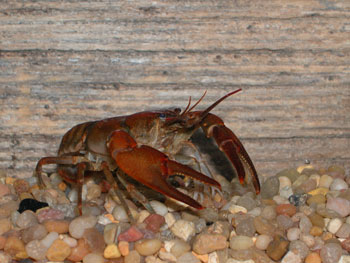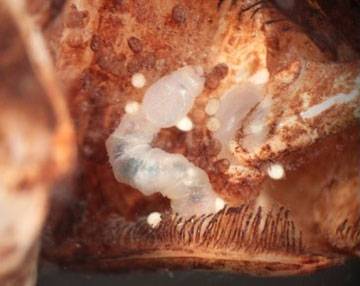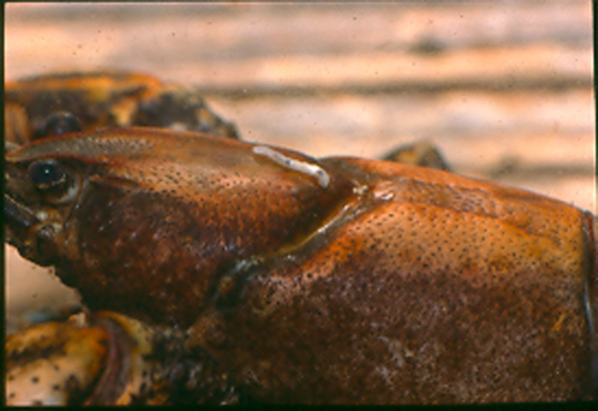A recent paper by researchers at Appalachian State University and Virginia Tech, published in the journal Ecology, titled: “Strong effects of a mutualism on freshwater community structure,” shows how some small worms can influence entire stream ecosystems. The worms are able to have these effects because they are engaged in a mutualism with crayfish which are well known to have strong effects on freshwater systems. This paper documents for the first time that a mutualism may affect the densities of other species in freshwater systems.
Mutualisms are interactions between members of different species that result in positive or beneficial effects on the survival and growth of both species involved. The focal mutualism, in this case, is between a crayfish host and the crayfish worms that live on the shell or exoskeleton of the crayfish. The crayfish worms, as they are commonly known, can increase the crayfish host’s growth and activity.
“A normal number of worms (say 3-6 worms) on a crayfish directly improves the crayfish’s growth and indirectly, via their impacts on the crayfish, influences the abundance of other invertebrate species in the community and the level of sediment that accumulates on the streambed” Dr. Robert Creed, professor, Department of Biology, Appalachian State University said.

A New River crayfish (Cambarus chasmodactylus), the crayfish species used in the experiment. Photo by Wayne Van Devender.
Crayfish can affect freshwater systems by eating various invertebrates and plants, both living and dead, as well as by bulldozing and excavating bottom sediments. A variety of species crayfish worms, formally known as branchiobdellidans, live on the exterior of crayfish species found across the northern hemisphere. Thus, it is likely that similar effects of these worms may occur in lakes and streams around much of the world.
“While the crayfish can benefit with increased survival and growth, the worms get a place to live and access to the resources that they feed on that are present on the exoskeleton of the crayfish,” said Creed.

A close up of a worm (Cambarincola ingens) surrounded by its eggs (referred to as cocoons). Photo by Dr. Robert Creed.
The authors of the paper are Dr. Robert Creed, professor, Department of Biology, Appalachian State University and Dr. Bryan Brown, associate professor, Department of Biological Sciences, Virginia Tech (and past Appalachian biology masters student ’99), along with Dr. James Skelton, now an assistant professor, Department of Biology, College of William and Mary and Dr. Kaitlin Farrell, now a lecturer, Odum School of Ecology, University of Georgia (also a former Appalachian biology masters student ’12).
“The effects and importance of mutualisms on biodiversity are well-known from terrestrial and marine systems,” said Creed. “In contrast, mutualisms are not as well studied in freshwater systems and their effects on these systems had not been demonstrated. This paper shows that mutualisms can have important effects on freshwater systems as well.”

Dr. Robert Creed, professor, Department of Biology, Appalachian State University and Dr. Bryan Brown, associate professor, Department of Biological Sciences, Virginia Polytechnic Institute and State University setting up an experiment. Dr. James Skelton is in the background; Dr. Kait Farrell is not shown. Photo courtesy of Bryan Brown.
About Dr. Robert Creed
Dr. Robert Creed received his B.S. in Zoology from UNC-Chapel Hill and his Ph.D. in Zoology with a focus on Ecology from Michigan State University. He joined Appalachian’s Department of Biology in 1996. He is a freshwater community ecologist and studies freshwater mutualisms, the ecology of crayfish and other aquatic invertebrates, as well as the importance of biodiversity for the functioning of stream ecosystems. The research described above was funded by a grant from the National Science Foundation awarded to both Creed and Brown in 2009.
###
About the Department of Biology
The Department of Biology is a community of teacher-scholars, with faculty representing the full breadth of biological specializations — from molecular genetics to landscape/ecosystem ecology. The department seeks to produce graduates with sound scientific knowledge, the skills to create new knowledge, and the excitement and appreciation of scientific discovery. Learn more at https://biology.appstate.edu.
By Ellen Gwin Burnette
Dec. 3, 2020
BOONE, N.C.

